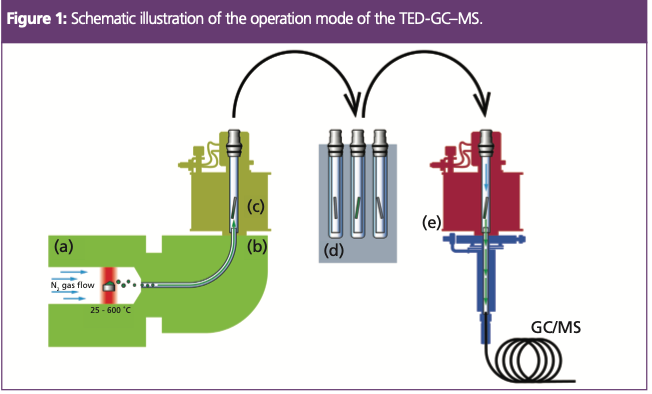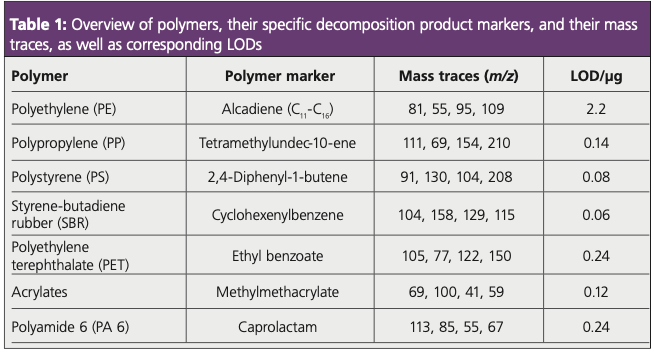Determination of Microplastic Mass Content by Thermal Extraction Desorption Gas Chromatography–Mass Spectrometry
A novel analysis technique has been developed for the determination of microplastics (MPs) in complex environmental samples using thermal extraction desorption gas chromatography–mass spectrometry (TED-GC–MS).
The scientific and practical challenge of detecting microplastics (MPs) in the environment in a targeted and rapid manner is solved by innovative coupling of thermogravimetric analysis with mass spectrometric methods. Fast identification and quantitative determination of most thermoplastic polymers and elastomers is possible by using thermal extraction desorption gas chromatography–mass spectrometry (TED-GC–MS).
The occurrence of microplastics (MPs) in the environment and in food products has been given much attention in academia and in public media for several years. MPs were defined as plastic particles with a diameter of 1–1,000 μm in the largest dimension (ISO/TR 21960) (1). One of the main sources of such particles entering the environment is improper disposal (“littering”) of macroplastics, such as plastic bottles, bags, or cups. Exposure parameters such as UV light, temperature, mechanical impact, and time lead to ageing and later to fragmentation of the macroplastics into MP particles. The most relevant polymers in terms of the amount of MPs introduced through littering are polyethylene (PE), polypropylene (PP), polystyrene (PS), polyethylene terephthalate (PET), polyamide 6 (PA), and acrylates. Another important entry pathway is the abrasion of automobile tyres. The impact of MPs on ecosystems and on human health is still unknown, but the fact that MPs are already ubiquitous tells us that improved monitoring and identification of entry pathways is needed, along with the development of efficient avoidance strategies.
For this, a rapid and robust analysis technique capable of detecting and quantifying the relevant types of plastics in various media is indispensable, in addition to a representative and meaningful sampling strategy (2,3). The analytical challenge is shaped by three main underlying facts:
- The concentration of MPs is usually low and they cover a wide range of particle dimensions (size, mass, form) in samples that can contain large amounts of natural organic or inorganic particles.
- Different environmental compartments, such as air, water, and solid matrices, differ widely in terms of their MP content and sample homogeneity.
- The chemical composition of MPs can be very similar to natural polymers, leading to false negative/positive analysis results.
- Existing analytical techniques for the detection of MP particles in samples are often time consuming in terms of the required sample preparation and/or offer often the number of particles and not the amount or mass. Such techniques may not adequately address the practical needs for monitoring work.
The Federal Institute for Materials Research and Testing (BAM) has developed a new analysis technique, thermal extraction desorption gas chromatography–mass spectrometry (TED-GC–MS), which performs MP determination even in complex environmental samples (4–6). TED-GC–MS identifies and quantifies MP mass content in environmental samples up to 100 mg through the determination of polymer-specific decomposition products, independent of the natural organic and inorganic matrix. If a homogeneous sample of this size is available, no additional time-consuming preparation steps are usually necessary. The method is optimized to analyze large series of samples and is applicable for different matrices. TED-GC– MS was developed into an analytical solution in collaboration with scientists from Gerstel.
Experimental
Thermal extraction is performed in a thermobalance (TGA2, Mettler/Toledo, Giessen, Germany) (Figure 1a). For this purpose, a few milligrams to over 100 milligrams of a sample are weighed into a 150-μL alumina crucible. The exact weight required depends on the sample type. The crucible is heated from 25 °C to 600 °C under constant nitrogen flow at a heating rate of 10 K/min. The thermobalance gas outlet is connected to a thermal desorption unit (TDU 2, Gerstel, Mülheim an der Ruhr, Germany) (Figure 1c) using a coupling device (Figure 1b). In the TDU, the solid phase adsorber made of polydimethylsiloxane (Sorb-Star, IMT Innovative Messtechnik GmbH, Vohenstrau, Germany) is located inside the replaceable TDU tube and is
used to trap and concentrate the polymer decomposition products (Figure 1d). The coupling device is operated at a constant temperature of 240 °C, the TDU at 40 °C. The TDU tube with the solid phase adsorber (loaded with the decomposition products) is then automatically transferred by a robot (MultiPurpose Sampler MPS, Gerstel) into another thermal desorption unit (TDU 2, Gerstel) connected to a GC–MS system (Figure 1e). Here, the decomposition products are thermally desorbed (50–200 °C, heating rate of 40 K/min, 5 min 200 °C isothermal, splitless mode) and transported with a constant helium gas flow to a cooled injection system (CIS 4, Gerstel). They are cryo-focused in the CIS 4 at −100 °C and re-released using a temperature program up to 270 °C (−100 to 270 °C, heating rate of 12 K/s). The remobilized products are separated in a gas chromatograph (7890, Agilent, Palo Alto, California, USA; chromatographic column: HP-5 ms, 40–300 °C, heating rate of 5 K/ min, 4 min 300 °C isothermal, 1 mL/min He flow, Agilent) and detected by a mass spectrometer (5973N, Agilent) with the scan mode in the range of m/z 35−350 (GC−MS-interface: 300 °C; MS: ion source, 230 °C; quadrupole, 150 °C; electron ionization at 70 eV).

TED-GC–MS is characterized by low limits of detection (LODs) and limits of quantification (LOQs) for the different polymers (Table 1) (7). The listed polymers are the most commonly used for plastic products such as bottles, bags and textile materials, to name a few. Styrene butadiene rubber is used on a large scale in automobile tyres and can be used as marker for tyre abrasion (5).

Identification and Quantification
Identification and quantification of the decomposition products formed during pyrolysis was performed (4). These were decomposition products (polymer markers) specific to the respective polymers. Table 1 shows some examples of specific decomposition products of the corresponding polymers.
Figure 2 shows an example of a TED-GC– MS chromatogram. The different polymer markers are separated chromatographically and elute at different retention times. Polymer quantification using TED-GC– MS provides good analytical robustness because a separate quantification can be performed for each marker.

To quantify the polymers, the peak areas of the respective markers are integrated and a mass content is determined using various calibration methods. Methods typical for chromatography are used for the calibration and can vary depending on the issue: external calibration, standard addition, response factors. External calibration is performed using a representative matrix that is free of plastics and adding different MP mass contents to create a calibration series based on which mass content in the sample is calculated. In standard addition, a defined amount of polymer is added to a sample during the second measurement. The MP mass content is obtained by the detected peak area difference. The mass content by response factors is calculated by measuring a defined amount of the pure polymers.
By using the ratio of peak area to mass, the MP mass content of the sample is calculated.
Good results were obtained in tests to investigate the recovery rates. For
this purpose, model matrices of natural organics and inorganics were mixed with a defined amount of plastics. Polystyrene, as an example, achieved a value of 98.8%. In order to carry out an assessment of the measurements, a five-fold deuterated polystyrene (all aromatic hydrogen atoms substituted by deuterium) was used as an internal standard. A blank measurement is taken between each sample measurement to record carry-over and device influences. The complete measurement of a sample takes only ~ 2 hours, a short time considering the sample mass and the depth of information.
In some very specific cases, false–positive signals of the matrix influenced the detection of polymer markers. For example, long chain fatty acids in wastewater samples or in samples with high content of biota overlaid the marker of PE. Additional fat extraction steps are then needed or a case-by-case evaluation of the various PE marker components C11 up to C16.
Practical Applications
The TED-GC–MS method enables the determination of microplastics mass content in air, water and soil samples.
In Figure 3, the results of TED-GC–MS measurements of an indoor dust sample, a water sample obtained by fractional filtration of surface water, a compost sample, and a bottled water sample are shown. The samples differ in the identified polymers as well as in their relative content.

In the dust sample, a high proportion of PET and lower proportions of PE
and PA were observed. PET and PA are components of textile materials and are a possible source of MP in in-house dust.
The water filtrate was obtained by fractional filtration. The fractionated suspended matter was analyzed separately. The resulting polymer mass fractions were added afterwards. PE, PET, PP, and PS were detected and quantified with a total mass content of ~ 50 μg/mg. These polymers are the most widely used in applications of plastics.
A similar polymer type distribution was found in the compost sample. PE, PP, and PS were identified with a polymer mass content of 1.87 μg/mg. The sample was analyzed without performing concentration steps. However, it was found that for such samples a homogenization is necessary to achieve a representative result in individual measurements.
The bottled water sample posed a challenge. Bottled water is relatively free
of solid components, which minimizes coelution of the polymer markers.
However, the polymer mass content was very low at <0.09 μg/L. A special mini-filter crucible with a mesh size of 5 μm was used (3). The filter crucibles enabled us to prepare filtrates directly without incurring losses by transferring sample material while also reducing the risk of contaminations.
Conclusions
Over years of gathering experience with the TED-GC–MS method and performing analyses of more than 1,000 samples from a wide range of sources, our conclusions are quite clear: The analysis of MPs is not only a question of detection, it requires a meaningful sampling process adapted to the requirements of the detection system and the sample type. This has required interdisciplinary knowledge transfer between experts in environmental sciences, polymer sciences, and analytical sciences.
A wide range of samples can be analyzed by TED-GC–MS. Further, TED-GC–MS allows the identification and quantification of the most common types of polymers, including polymers of tyre-abrasion material. The method is fast, rugged, and allows implementation of quality control measures such as adding an internal standard, performing blank runs, and determining recovery rates. Depending on the sample type, only minimal sample preparation is necessary. TED-GC–MS can be used for samples from different environmental sources.
TED-GC–MS determines mass content and does not offer information about particle size, which is of relevance for the risk assessment. However, this can be overcome by developing smart sampling strategies or by sample preparation, for example fractionated filtration. Our work has demonstrated that TED-GC–MS is suitable for environmental monitoring.
References
1. ISO/TR 21960:2020, Plastics — Environmental aspects — State of knowledge and methodologies (ISO/TR 21960:2020).
2. C.G. Bannick, R. Szewzyk, M. Ricking, S. Schniegler, N. Obermaier, A.K. Barthel, K. Altmann, P. Eisentraut, and U. Braun, Wat. Res., 149, 650–658 (2019).
3. U. Braun, K. Altmann, D. Herper, M. Knefel, M. Bednarz, and C.G. Bannick, “Smart filters for the analysis of microplastic in beverages filled in plastic bottles”, Food Addit. Contam. Part A (2021) (Paper Status: ACCEPTED)
4. E. Dümichen, J. Chrom. A. 1592, 133–142 (2019).
5. P. Eisentraut, E. Dümichen, A.S. Ruhl, M. Jekel, M. Albrecht, M. Gehde, and U. Braun, Environ. Sci. Technol. Lett. 5(10), 608–613 (2018).
6. C. Goedecke, D. Dittmann, P. Eisentraut, Y. Wiesner, B. Schartel, P. Klack, and U. Braun, J. Anal. Appl. Pyrolysis 152, 104961 (2020).
7. M. Kittner, P. Eisentraut, D. Dittmann, and U. Braun, “Decomposability versus detectability: First validation of TED-GC/MS for microplastic detection in different environmental matrices” (2021) (Paper Status: UNPUBLISHED).
Yosri Wiesner started at The Federal Institute for Materials Research and Testing (Bundesanstalt für Materialforschung und -prüfung — BAM), Berlin, Germany, in 2018 as a doctoral student after receiving his master’s degree in geological sciences at the Free University of Berlin. His tasks include the qualitative and quantitative determination of microplastics in water samples by TED-GC–MS with the aim of identifying degradation mechanisms. Korinna Altmann works as scientist in the department of polymer analytics, BAM. Korinna completed her doctoral thesis in 2015 at the Free University of Berlin on a joint project with BAM in the field of polymer surfaces before joining a project on glass fibre surfaces, and the first national microplastics project in 2016. Her work includes the establishment and further development of TED-GC–MS for thermal analysis of microplastics in environmental samples, as well as the development of realistic polymer reference materials for microplastics analysis. Ulrike Braun is Head of the Waste Water Analysis, Monitoring Methods unit, at the the German Environment Agency (Umweltbundesamt — UBA), Berlin, Germany, as of 2021. Previously, Ulrike worked as a scientist at BAM for almost 20 years. She completed her doctorate in 2004 at the Free University of Berlin on the topic of flame-retardant polymers and has since worked on polymer-specific projects. In 2015, Ulrike developed the TED-GC–MS technique as a rapid screening method for the analysis of microplastics. She has worked on numerous national and international projects and is heavily involved in the standardization of microplastics analysis at an international level.
E-mail: yosri.wiesner@bam.de
Website: www.bam.de & www.uba.de

University of Rouen-Normandy Scientists Explore Eco-Friendly Sampling Approach for GC-HRMS
April 17th 2025Root exudates—substances secreted by living plant roots—are challenging to sample, as they are typically extracted using artificial devices and can vary widely in both quantity and composition across plant species.
Miniaturized GC–MS Method for BVOC Analysis of Spanish Trees
April 16th 2025University of Valladolid scientists used a miniaturized method for analyzing biogenic volatile organic compounds (BVOCs) emitted by tree species, using headspace solid-phase microextraction coupled with gas chromatography and quadrupole time-of-flight mass spectrometry (HS-SPME-GC–QTOF-MS) has been developed.
Fundamentals of Benchtop GC–MS Data Analysis and Terminology
April 5th 2025In this installment, we will review the fundamental terminology and data analysis principles in benchtop GC–MS. We will compare the three modes of analysis—full scan, extracted ion chromatograms, and selected ion monitoring—and see how each is used for quantitative and quantitative analysis.
Quantifying Microplastics in Meconium Samples Using Pyrolysis–GC-MS
March 26th 2025Using pyrolysis-gas chromatography and mass spectrometry, scientists from Fudan University and the Putuo District Center for Disease Control and Prevention detected and quantified microplastics in newborn stool samples.

.png&w=3840&q=75)

.png&w=3840&q=75)



.png&w=3840&q=75)



.png&w=3840&q=75)






